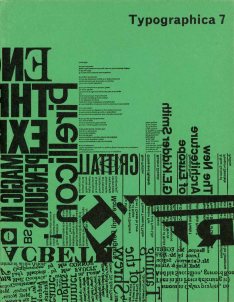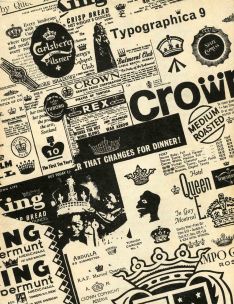Lund Humphries Landmarks – Typographica, edited by Herbert Spencer (1949-67)
Rick Poynor explains the importance of the influential typographic-design journal Typographica, published by Lund Humphries over an 18-year period.
Typographica, published by Lund Humphries in two series from 1949 to 1967, is one of the most outstanding visual arts magazines of the post-war years. The brainchild of a 25-year-old typographer, Herbert Spencer (1924-2002), it was unusual not only for the originality of its editorial vision and its exceptional production values, but also for its longevity, especially since it was never expected to make a profit. For Lund Humphries, then also a printer, it provided a magnificent vehicle to show what the Bradford printing works could achieve. Eric C. Gregory, the firm’s chairman, offered Spencer his services as publisher and remained a committed supporter. Spencer edited Typographica, designed it and wrote articles, while pursuing a career as a graphic designer, design consultant, author, editor and teacher, all of which would establish him as a leading figure in post-war British communication design.
For many years after Typographica was brought to a close by mutual agreement, the 32 issues tended to be seen primarily as a channel for Continental Modernist approaches to typographic design. While the magazine played a crucial role in these developments in Britain, it also presented an eclectic synthesis of Modernist history, new typography and graphic design, traditional printing history, avant-garde experimentation, and photography of the city and street that helped to expand designers’ sense of what the emerging discipline of graphic design could be.
A nostalgic Victoriana permeated the British typography scene in the post-war years and Typographica both assimilated and transcended these tendencies. Spencer had a collagist’s flair for assembly and his layouts for articles about printer’s fists, printer’s stock blocks, newspaper seals, and clip art were intricately balanced constructions that delighted the eye. In the 1960s, he was a keen photographer, with a darkroom at home, and published many of his own pictures in the magazine. By the second series, he was using his camera as an alternative kind of ‘pen’ to conceive and give shape to the articles. Influenced by the great American photographer Walker Evans, Spencer was committed to the idea of running photographs in series and Typographica’s long articles allowed extended picture sequences. These concerns led him into discussion with renowned art critic John Berger, who in 1965 contributed to the magazine an early statement of his ideas about the need for new relations between words and images.
In its later issues, Typographica offered a suggestive juxtaposition of professional graphic design and concurrent movements in concrete poetry and typographic art – the work of Dieter Roth, Ian Hamilton Finlay and Stefan Themerson featured, for example. These parallel strands, which were equally fascinating to Spencer, imply a potential fusion of design in business printing (Spencer’s term) and aesthetic experimentation that the magazine could never fully spell out or resolve in its writing and commentary. As a publication, Typographica became an ambitious, intuitive, visually complex ‘work’ in its own right, while also looking forward to the expressive typography that would flourish in the digital design of the 1990s.
Rick Poynor
Rick Poynor is a writer, lecturer and curator specialising in design, photography and visual culture. He founded Eye magazine and edited it from 1990 to 1997. Alongside contributions to international publications including Eye, Print, Creative Review, Blueprint, Frieze, and the Design Observer website which he co-founded, his books include Typographica (2001), No More Rules: Graphic Design and Postmodernism (2003) and Communicate: Independent British Graphic Design Since the Sixties (2004).



